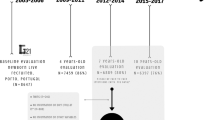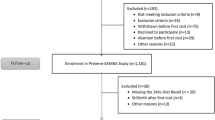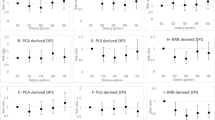Abstract
Objective:
The effect of energy adjustment on variables entered into principal component analysis (PCA) to derive dietary patterns has received little attention.
Design and methods:
As part of regular self-completion questionnaires, used in the Avon Longitudinal Study of Parents and Children, pregnant women were asked to record the frequency of consumption of a variety of food items. A total of 12 053 women completed the questionnaire. Individual dietary types were identified using PCA, before and after adjusting the food variables for energy intake. Associations with estimated nutrient intakes and with birthweight were examined for the two solutions and when energy adjustment was performed at a later stage of the analysis.
Results:
Slight differences were seen in terms of the components extracted and the factor loadings obtained. The associations with nutrient intakes showed that there was a general reduction in the size of the correlation coefficients for the energy-adjusted components compared to the unadjusted components. There did not appear to be any difference in the size of the effects of the dietary pattern scores on birthweight, whether energy was adjusted for before entry into the PCA or after.
Conclusions:
In this sample, it is not necessary to adjust for energy intake before entry into a PCA analysis to determine dietary patterns when using food frequency questionnaire data. Effects of energy intake can be determined at a later stage in the analytical process.
This study determines the effect of adjusting for energy on dietary patterns resulting from PCA and the subsequent effect on future outcomes.
This is a preview of subscription content, access via your institution
Access options
Subscribe to this journal
Receive 12 print issues and online access
$259.00 per year
only $21.58 per issue
Buy this article
- Purchase on Springer Link
- Instant access to full article PDF
Prices may be subject to local taxes which are calculated during checkout
Similar content being viewed by others
References
Balder HF, Virtanen M, Brants HAM, Krogh V, Dixon LB, Tan F et al. (2003). Common and country-specific dietary patterns in four European cohort studies. J Nutr 133, 4246–4251.
Bamia C, Orfanos P, Ferrari P, Overvad K, Hundborg HH, Tjonneland A et al. (2005). Dietary patterns among older Europeans: the EPIC-elderly study. Br J Nutr 94, 100–113.
Barker ME, McClean SI, Thompson KA, Reid NG (1990). Dietary behaviours and sociocultural demographics in Northern Ireland. Br J Nutr 64, 319–329.
Bland M (2000). An Introduction to Medical Statistics 3rd edn. Oxford University Press: Oxford.
Cattell RB (1966). The screen test for the number of factors. Multivariate Behav Res 1, 245–276.
Costacou T, Bamia C, Ferrari P, Riboli E, Trichopoulos D, Trichopoulou A (2003). Tracing the Mediterranean diet through principal components and cluster analysis in the Greek population. Eur J Clin Nutr 57, 1378–1385.
Golding J, Pembrey M, Jones R, ALSPAC Study Team (2001). ALSPAC – The Avon Longitudinal Study of Parents and Children. Paediatr Perinat Epidemiol 15, 74–87.
Gorsuch RL (1974). Factor Analyses. WB Saunders: Philadelphia, PA.
Gregory J, Foster K, Tyler H, Wiseman M (1990). The Dietary and Nutritional Survey of British Adults. Office of Population Censuses and Surveys, Chapter 13: Classification of Types of Diet. HMSO: London.
Hoffman K SM, Schienkiewtz A, Nothlings U, Boeing H (2004). Application of a new statistical method to derive dietary patterns in nutritional epidemiology. Am J Epidemiol 159, 935–944.
Hu FB, Rimm E, Smith-Warner SA, Feskanich MJ, Stampfer MJ, Ascherio A et al. (1999). Reproducibility and validity of dietary patterns assessed with a food-frequency questionnaire. Am J Clin Nutr 69, 243–249.
Hu FB (2002). Dietary pattern analysis: a new direction in nutritional epidemiology. Curr Opin Lipidol 13, 3–9.
Jakes RW, Day NE, Luben R, Welch A, Bingham S, Mitchell J et al. (2004). Adjusting for energy intake – what measure to use in nutritional epidemiological studies? Int J Epidemiol 33, 1382–1386.
Khani BR, Ye W, Terry P, Wolk A (2004). Reproducibility and validity of major dietary patterns among Swedish women assessed with a food-frequency questionnaire. J Nutr 134, 1541–1545.
Kipnis V, Subar AF, Midthune D, Freedman LS, Ballard-Barbash R, Troiano RP et al. (2003). Structure of dietary measurement energy: results of the OPEN Biomarker Study. Am J Epidemiol 158, 14–21.
Kline P (1994). An Easy Guide to Factor Analysis. Routledge: London.
Martinez ME, Marshall JR, Sechrest L (1998). Invited commentary: factor analysis and the search for objectivity. Am J Epidemiol 148, 17–19.
Martinez-Ortiz JA, Fung TT, Baylin A, Hu FB, Campos H (2006). Dietary patterns and risk of nonfatal acute myocardial infarction in Costa Rican adults. Eur J Clin Nutr 60, 770–777.
McNaughton SA, Mishra GD, Bramwell G, Paul AA, Wadsworth MEJ (2005). Comparability of dietary patterns assessed by multiple dietary assessment methods: results from the 1946 British Birth Cohort. Eur J Clin Nutr 59, 341–352.
Northstone K, Emmett P, the ALSPAC Study Team (2005). Multivariate analysis of diet in children at four and seven years of age and associations with socio-demographic characteristics. Eur J Clin Nutr 59, 751–760.
Rogers I, Emmett P, the ALSPAC Study Team (1998). Diet during pregnancy in a population of pregnant women in South West England. Eur J Clin Nutr 52, 246–250.
The Royal Society of Chemistry and MAFF (1988). Cereals and Oat Products. HMSO: London.
The Royal Society of Chemistry and MAFF (1989). Milk Products and Eggs. HMSO: London.
The Royal Society of Chemistry and MAFF (1991a). The Composition of Foods 5th edn. HMSO: London.
The Royal Society of Chemistry and MAFF (1991b). Vegetables, Herbs and Spices. HMSO: London.
The Royal Society of Chemistry and MAFF (1992a). Fruits and Nuts. HMSO: London.
The Royal Society of Chemistry and MAFF (1992b). Vegetable Dishes. HMSO: London.
The Royal Society of Chemistry and MAFF (1993). Fish and Fish Products. HMSO: London.
Togo P, Heitmann BL, Sorensen TIA, Osler M (2003). Consistency of food intake factors by different dietary assessment methods and population groups. Br J Nutr 90, 667–678.
van Dam RM, Grievink L, Ocke MC, Feskens EJM (2003). Patterns of food consumption and risk factors for cardiovascular disease in the general Dutch population. Am J Clin Nutr 77, 1156–1163.
Velie EM, Schairer C, Flood A, He JP, Khattree R, Schatzkin A (2005). Empirically derived dietary patterns and risk of postmenopausal breast cancer in a large prospective cohort study. Am J Clin Nutr 82, 1308–1319.
Waijers PMCM, Ocke MC, van Rossum CTM, Peeters PHM, Bamia C, Chloptsios Y et al. (2006). Dietary patterns and survival in older Dutch women. Am J Clin Nutr 83, 1170–1176.
Willett WC (1989). Nutr Epidemiol 2nd edn. Oxford University press: New York.
Willett W (2001). Commentary: dietary diaries versus food frequency questionnaires – a case of undigestible data. Int J Epidemiol 30, 317–319.
Acknowledgements
We are extremely grateful to all the families who took part in this study, the midwives for their help in recruiting them and the whole ALSPAC team, which includes interviewers, computer and laboratory technicians, clerical workers, research scientists, volunteers, managers, receptionists and nurses. The UK Medical Research Council, the Wellcome Trust and the University of Bristol provided core support for ALSPAC. This work was also partially funded by a Wellcome Trust VIP award to KN and by the Arthritic Association supporting KN and PME. This publication is a work by us. We all contributed to the writing of the article. We have no conflict of interest.
Author information
Authors and Affiliations
Corresponding author
Additional information
Guarantor: K Northstone.
Contributors: KN was responsible for the data analysis and interpretation and drafted the manuscript. PME and IR were responsible for the design, collection and availability of the dietary data and revision of the manuscript. All authors contributed to the intellectual content and approved the final version of the manuscript.
Rights and permissions
About this article
Cite this article
Northstone, K., Ness, A., Emmett, P. et al. Adjusting for energy intake in dietary pattern investigations using principal components analysis. Eur J Clin Nutr 62, 931–938 (2008). https://doi.org/10.1038/sj.ejcn.1602789
Received:
Revised:
Accepted:
Published:
Issue Date:
DOI: https://doi.org/10.1038/sj.ejcn.1602789
Keywords
This article is cited by
-
The differential effect of maternal dietary patterns on quantiles of Birthweight
BMC Public Health (2020)
-
Weight development between age 5 and 10 years and its associations with dietary patterns at age 5 in the ABCD cohort
BMC Public Health (2020)
-
The relationship between maternal dietary patterns during pregnancy in women with gestational diabetes mellitus and infant appetitive feeding behaviour at 6 months
Scientific Reports (2020)
-
Ethnicity and socioeconomic status are related to dietary patterns at age 5 in the Amsterdam born children and their development (ABCD) cohort
BMC Public Health (2018)
-
Dietary patterns and changes in frailty status: the Rotterdam study
European Journal of Nutrition (2018)



